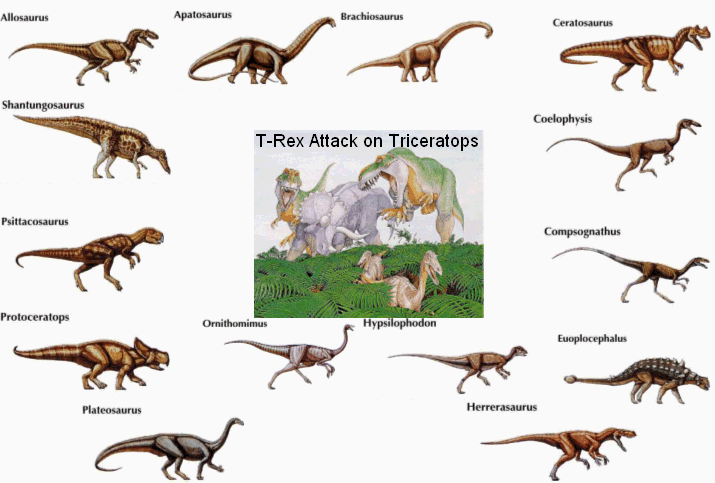
What Happened to the Dinosaurs?
 |
The Discovery of Dinosaurs
Dinosaur fossils were first discovered in the early 1800s
The term "dinosaur", which means "terrible lizard", was coined in 1841 by the famous paleontologist, Sir Richard Owen.
Since these early finds, more than 1,000 different sites containing dinosaur fossils have been uncovered around the world
From 1870 into the early 1900s, two men dominated the search for dinosaurs in the western United States:
Othniel Charles Marsh and
Edward Drinker Cope.
Places Where Dinosaur Fossils Have Been Found
|
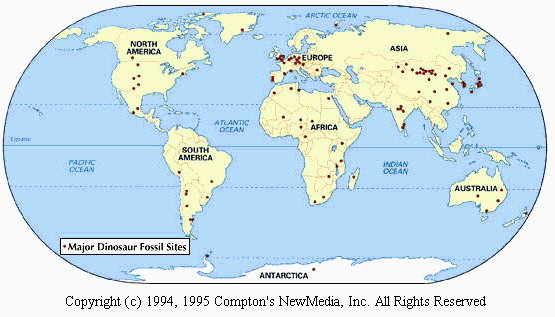 |
Evolutionary Theory on Dinosaurs
Evolutionists believe that dinosaurs "evolved" about 230 million years ago and then died out about 65 million years ago.
Evolutionists are uncertain as to why dinosaurs went extinct.
Supposed Dinosaur Evolution
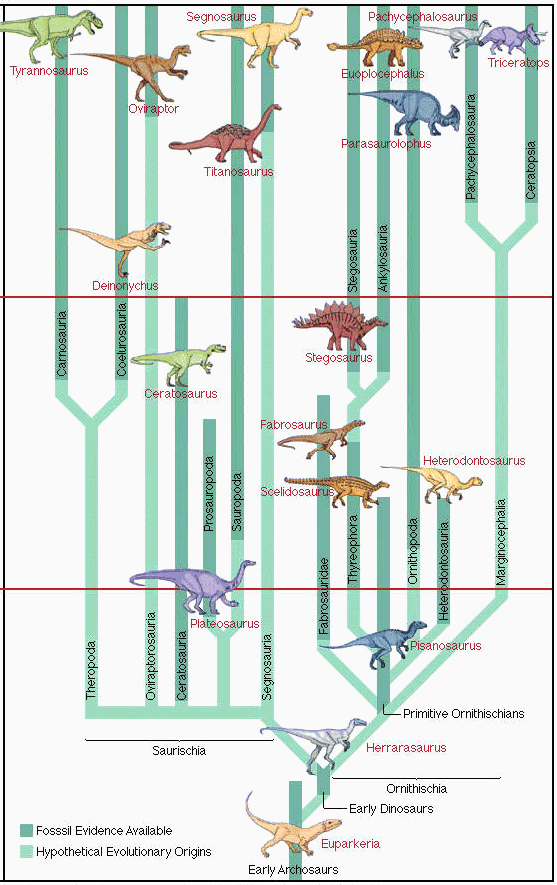 |
| Note that based on the legend in the lower left hand corner, there is no fossil evidence to show evolution from one dinosaur type to another. The "hypothetical evolutionary origins" are based on the presupposition that all living things evolved. |
Biblical Perspective on Dinosaurs
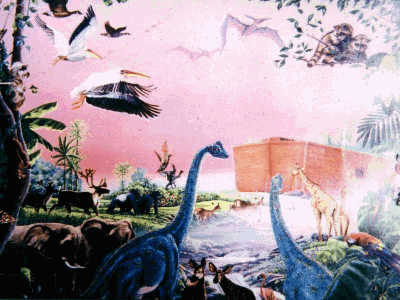 |
Dinosaurs would have been included in the animals created on the fifth and sixth days of creation.
If the dinosaurs lived until the time of Noah's flood . . .
Many dinosaurs would have perished in the flood - leaving numerous fossils.
Dinosaurs would have been among those animals that God preserved on the ark.
The apparent extinction of dinosaurs today would have taken place after the flood - perhaps due to changing conditions on the earth.
Evidence That Dinosaurs and Man Coexisted
Ancient Legends
Possible Biblical References
Behemoth (Job 40)
Leviathan (Job 41)
Present Day Examples?
Ancient Legends May Show That Man Co-Existed With Dinosaurs
Examples given by Ham, Snelling, and Wieland, The Answers Book - Answers to the 12 most-asked questions on Genesis and Creation/Evolution, pp.21-39
Just as nearly every culture of the world has flood stories similar to the account given in Genesis 6-9, many different cultures also have dragon legends.
China - China has always been renowned for its dragon stories. Dragons have always been prominent on Chinese pottery, embroidery and carvings.
England - England has its story of St. George, who slew a dragon that lived in a cave.
Ireland - In the tenth century, an Irishman wrote of his encounter with what appears to have been a Stegosaurus.
Italy - A well-known naturalist of the time, Ulysses Aldrovandus, recorded an encounter between a peasant named Baptista and a dragon whose description fits that of the dinosaur Tanystropheus. The encounter was on May 13, 1572 near Bologna in Italy, and the peasant killed the dragon.
Ancient Sumeria - There is a Sumerian story dating back to 3,000 BC that tells of a hero named Gilgamesh who, when he went to a remote forest, encountered a huge dragon which he slew, cutting off its head as a trophy.
India - When Alexander the Great and his soldiers marched into India, they found that the Indians worshipped huge hissing reptiles that they kept in caves.
Europe - In the 1500s, a European scientific book Historia Animalum, listed several animals as still being alive that we would classify as dinosaurs.
No human being has ever seen a live dinosaur. (National Geographic Jan. 1993)
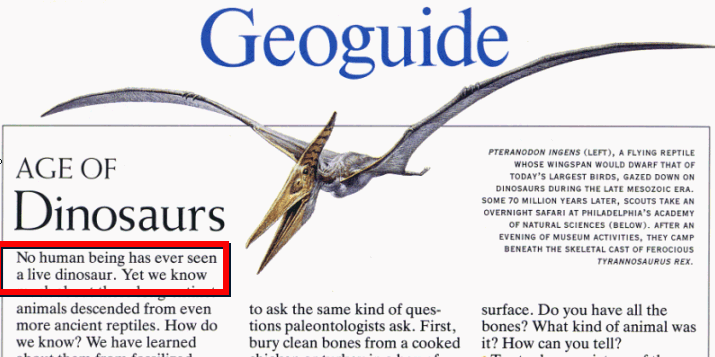 |
Then why did they draw them, carve them, and write about them?
For Example:
o Long necked creature found on hippo tusk magic wand in tomb of Inherka. (12th century BC in Egypt.)
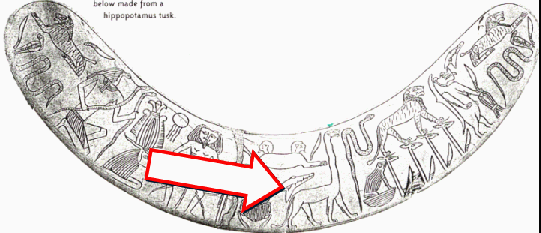 |
| For more on dinosaurs on ancient art work contact John Goertzen, bluejay@birdlover.com www.rae.org. |
o Russian medallion
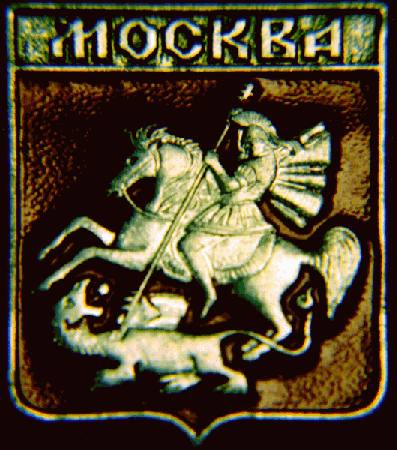 |
o Viking ships often had a dragon head. (1000 A.D.)
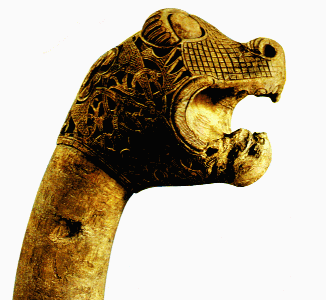 |
|
| From the Oseberg Viking ship burial - The Vikings, p.17 |
o Marco Polo lived in China for 17 yrs. around 1271 A.D. and reported that the emperor raised dragons to pull his chariots in parades. In 1611 the emperor appointed the post of a Royal Dragon Feeder. Books even tell of Chinese families raising dragons to use their blood for medicines and highly prizing their eggs.
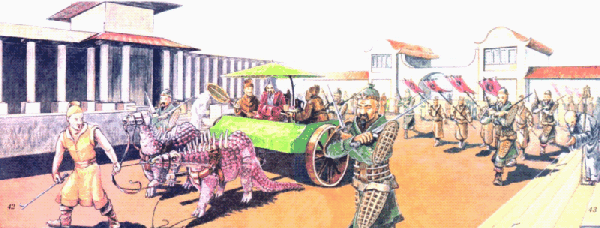 |
|
| (DeVisser, Marinus Willem, The Dragon in China & Japan, 1969.) |
o Indian pictograph, found in the Havasupai canyon in Grand Canyon.
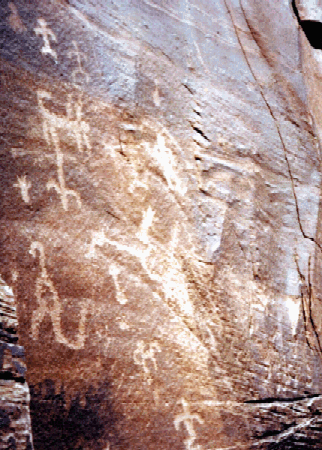 |
|
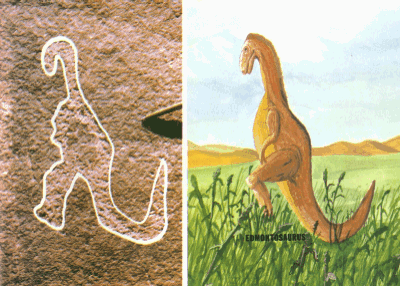 |
|
|
Photo taken by Dr. DeLancy; 719 S. Main St. Perkasie, PA 18944; His widow has the originals. |
o Hans Egede, Missionary to Greenland, drew a sketch of a sea monster he saw off the coast of Greenland in 1734.
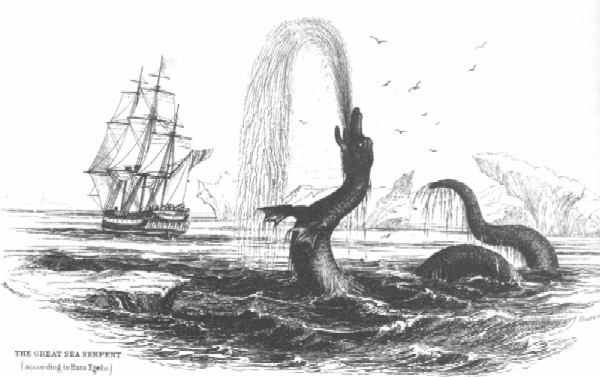 |
|
| S.M. McAllister 205-773-7823 is a living descendant. |
Ancient Legends May Show That Man Co-Existed With Dinosaurs
If the accounts given in ancient histories of dragons are really descriptions of encounters of men with (what we would classify as) dinosaurs, then there is quite a bit of evidence that man and dinosaurs coexisted!
Evidence That Dinosaurs and
Man Coexisted
Possible Biblical
References:
Behemoth (Job 40)
Leviathan (Job 41)
Sea Monsters?
Brief Introduction to the Book of Job
 |
Historical Background (as given in the NIV Study Bibles Introduction to the Book of Job)
Written by an (Unknown) Israelite
About Job, a Non-Israelite
Who Lived sometime in the Second Millennium B.C.
Job 1-2 - Job, a wealthy and righteous man, loses everything:
His camels and sheep and oxen were stolen or killed
His ten children all died
His wife turned against him
He lost his health. Job was covered with boils from the top of his head to the bottom of his feet.
Job 3-37 - Three Friends and a Younger Man Dialog With Job About His Suffering and Losses
Jobs friends argue that Jobs suffering and loss must have resulted from sin or unrighteousness on Jobs part.
Job, while acknowledging that he is not sinless, questions whether what he has done calls for the kind of suffering that he has endured.
Job ends by calling on God to respond to his defense!
Job 31:35 - Oh, that I had someone to hear me! I sign now my defense-- let the Almighty answer me; let my accuser put his indictment in writing.
Job 38-42 - God answers Job and Job repents!
God asks Job a series of 84 questions designed to show Job that he has no right to question God.
Job 38:1-3 - Then the LORD answered Job out of the storm. He said: "Who is this that darkens my counsel with words without knowledge? Brace yourself like a man; I will question you, and you shall answer me.
Job 38:4 - Where were you when I laid the earth's foundation?
Job 38:32 - Can you bring forth the constellations in their seasons?
Job 39:19 - Do you give the horse his strength?
Job 39:26 - Does the hawk take flight by your wisdom?
Job repents for having challenged God and God restores Jobs prosperity, giving him twice what he had before.
Behemoth?
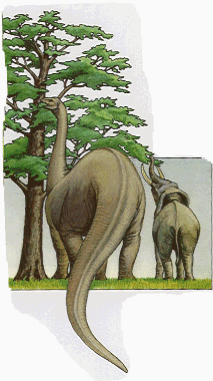 |
Job 40:15-24 - Look at the behemoth, which I made along with you and which feeds on grass like an ox. What strength he has in his loins, what power in the muscles of his belly! His tail sways like a cedar; the sinews of his thighs are close-knit. His bones are tubes of bronze, his limbs like rods of iron. He ranks first among the works of God, yet his Maker can approach him with his sword. The hills bring him their produce, and all the wild animals play nearby. Under the lotus plants he lies, hidden among the reeds in the marsh. The lotuses conceal him in their shadow; the poplars by the stream surround him. When the river rages, he is not alarmed; he is secure, though the Jordan should surge against his mouth. Can anyone capture him by the eyes, or trap him and pierce his nose?
|
Behemoth, according to Brown-Driver-Briggs Hebrew Dictionary: Perhaps an extinct dinosaur; a Diplodocus or Brachiosaurus, exact meaning unknown
Leviathan?
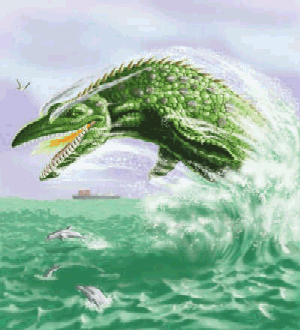 |
Job 41:1-34 - "Can you pull in the leviathan with a fishhook or tie down his tongue with a rope? 2 Can you put a cord through his nose or pierce his jaw with a hook? 3 Will he keep begging you for mercy? Will he speak to you with gentle words? 4 Will he make an agreement with you for you to take him as your slave for life? 5 Can you make a pet of him like a bird or put him on a leash for your girls? 6 Will traders barter for him? Will they divide him up among the merchants? 7 Can you fill his hide with harpoons or his head with fishing spears? 8 If you lay a hand on him, you will remember the struggle and never do it again! 9 Any hope of subduing him is false; the mere sight of him is overpowering. 10 No one is fierce enough to rouse him. Who then is able to stand against me? |
| 11 Who has a claim against me that I must pay? Everything under heaven belongs to me. 12 "I will not fail to speak of his limbs, his strength and his graceful form. 13 Who can strip off his outer coat? Who would approach him with a bridle? 14 Who dares open the doors of his mouth, ringed about with his fearsome teeth? 15 His back has rows of shields tightly sealed together; 16 each is so close to the next that no air can pass between. 17 They are joined fast to one another; they cling together and cannot be parted. 18 His snorting throws out flashes of light; his eyes are like the rays of dawn. 19 Firebrands stream from his mouth; sparks of fire shoot out. 20 Smoke pours from his nostrils as from a boiling pot over a fire of reeds. 21 His breath sets coals ablaze, and flames dart from his mouth. 22 Strength resides in his neck; dismay goes before him. 23 The folds of his flesh are tightly joined; they are firm and immovable. 24 His chest is hard as rock, hard as a lower millstone. 25 When he rises up, the mighty are terrified; they retreat before his thrashing. 26 The sword that reaches him has no effect, nor does the spear or the dart or the javelin. 27 Iron he treats like straw and bronze like rotten wood. 28 Arrows do not make him flee; slingstones are like chaff to him. 29 A club seems to him but a piece of straw; he laughs at the rattling of the lance. 30 His undersides are jagged potsherds, leaving a trail in the mud like a threshing sledge. 31 He makes the depths churn like a boiling caldron and stirs up the sea like a pot of ointment. 32 Behind him he leaves a glistening wake; one would think the deep had white hair. 33 Nothing on earth is his equal-- a creature without fear. 34 He looks down on all that are haughty; he is king over all that are proud." |
Leviathan, according to Brown-Driver-Briggs Hebrew Dictionary:
Leviathan, sea monster, dragon
Large aquatic animal
Perhaps the extinct dinosaur, plesiosaurus, exact meaning unknown
Sea Monsters?
 |
Psalm 74:13 - It was you [God] who split open the sea by your power; you broke the heads of the monster in the waters.
Psalm 148:7 Praise the LORD from the earth, you great sea creatures and all ocean depths,
Isaiah 27:1 - In that day, the LORD will punish with his sword, his fierce, great and powerful sword, Leviathan the gliding serpent, Leviathan the coiling serpent; he will slay the monster of the sea.
Brown-Driver-Briggs Hebrew Dictionary:
Hebrew: !yNIT; (tanniyn)
Dragon, serpent, sea monster
Dragon or dinosaur
Sea or river monster
Serpent, venomous snake
Evidence That Dinosaurs and
Man Coexisted
Present Day Examples?
o 42 year veteran missionary, Eugene Thomas (retired now, 3216 Dove Dr. SW. Warren, Ohio 330-824-3544) had two pygmies in his church in Congo, Africa that claimed to have killed a Mokele-Mbembe in 1959.
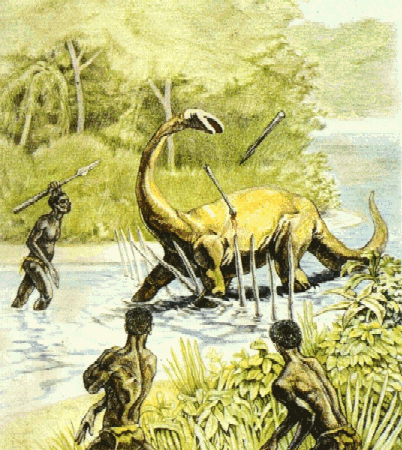 |
o Mentioned in the Boston Herald, June 29,1999:
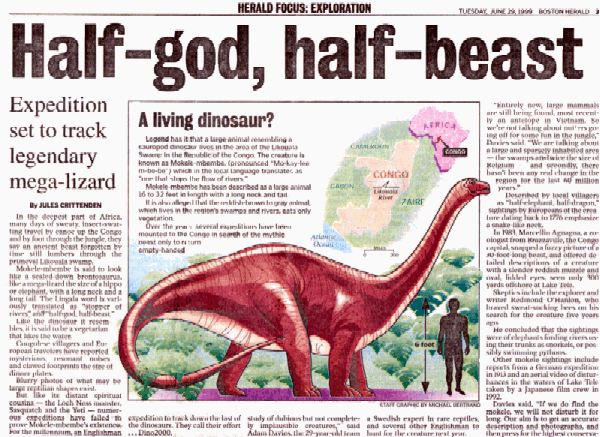 |